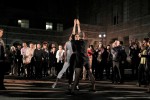Under a cloak of stars stand two figures, a dancer low to the ground reaching up to an audience member standing tall, looking gently down. The dancer reaches for the hand of the audience member until, with her assistance, they meet on the same level.
This Saturdayon the Royce Hall Terrace, the contemporary dance company Ate9 dANCEcOMPANYperformed “Exhibit o.” Choreographed by Danielle Agami, a former Batsheva Dance Company member and founder of Ate9 dANCEcCOMPANY, “Exhibit o” managed to construct a novel but intimate experience between both audience member and dancer alike. By putting the two contrasting figures in one space, “Exhibit o” shattered the traditional barriers of performance, obscuring the distinction between onlooker and performer.
At the start of the performance, audience members were instructed to scatter throughout the terrace. A few moments of confusion reigned until a sudden realization settled in. There was no stage and the figure near – or even directly beside you – could be a dancer. An atmosphere of expectancy settled over the group. It was only by one subtle, yet deviant, movement that audience members became aware that the performance had begun.
Backing away from the dancer in its space, the crowd looked around at the start of “Exhibit o” to see other pockets of people shift to accommodate the dancers scattered throughout the terrace. Some couples and groups of friends became separated andwere forced to huddle with other unsuspecting strangers. Though haphazardly disseminated, the crowd appeared equally captivated by the calm and languid movements of each respective dancer in their space.
As the performance continued, Ate9 dANCEcOMPANY members continually moved throughout the area forcing the crowd to take on a nebulous dance of its own right. Beyond shifting to accommodate dancers, the audiencewas also involved directly in the performance,as they were gently approached by company members. Though such an invasion of space might perturb certain individuals, many of those chosen remained calm and erect as respective dancers brought the surrounding crowd’s focus on them as well.
While Ate9 dANCEcOMPANY spontaneously altered the dynamics of the crowd, its movements varied from relaxed and languorous to deliberate and rapid. Such actions are in the fashion of Gaga, the language movement form created by the artistic director of the Batsheva Dance Company, Ohad Naharin. These movements appeared to breach the formulaic constrictions that define classical forms of dance without compromising those foundations. While an Ate9 dANCEcOMPANY company member’s center of weight remained non-traditionally lower and heavy, a sudden extension of leg or arm altered this grounded paradigm of movement, lifting that weight up and extending limbs to classical proportions.
Through choreography and interaction with the audience, the company seemed to express the frustration of miscommunication by attempting to break that divide. Many times dancers would pair up, face each other and remain still for extended period of time, lean on each other and connect in touch yet remain apart as one moved on the ground and other stood tall. They wandered throughout the audience, handing chairs to various unsuspecting spectators, who followed the lead of others and stood upon these chairs to more easily see the entirety of the dance.
Toward the end of the dance, Ate9 dANCEcOMPANY compounded its mediums of disconnected expression to also include voice. With a continual wandering, dancers halted in pairs next to various crowd members. Quietly, without theatrical projection, one company member repeated a telephone operator’s English chant of “press one to…” to the frustration of another company member who responded with rapid Hebrew.
These last actions of disconnection closed the piece as company members gathered the various chairs throughout theterrace and aligned them together so that the audience could view the talk that would follow.
Agami sat quietly between her mentor Naharin and Kristy Edmunds, the executive and artistic director for the Center for the Art of Performance at UCLA. Agami said she worked to make the impossible tangible and that she is happy to be able to think, dance and move. Her most poignant comment was an astray remark spoken directly to Naharin and repeated by Edmunds.
“I see us many years ago, somewhere else,” Agami said.
Agami, sitting next to Naharin, choreographer to choreographer,not only embodied an innovative artistic creation as a dancer but also joined the ranks of Naharin to form that vision herself.
“Certain dancers will begin the process of becoming a choreographer, and it’s a very different craft,” Edmunds said. “When I first experienced her work, I knew that she would be another generation’s voice that comes from a kind of lineage but becomes itself.”
– Yazmine Mihojevich
